Related Research Articles
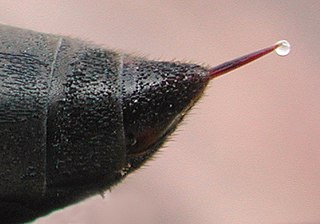
Venom or zootoxin is a type of toxin produced by an animal that is actively delivered through a wound by means of a bite, sting, or similar action. The toxin is delivered through a specially evolved venom apparatus, such as fangs or a stinger, in a process called envenomation. Venom is often distinguished from poison, which is a toxin that is passively delivered by being ingested, inhaled, or absorbed through the skin, and toxungen, which is actively transferred to the external surface of another animal via a physical delivery mechanism.
An allergen is an otherwise harmless substance that triggers an allergic reaction in sensitive individuals by stimulating an immune response.
Morning sickness, also called nausea and vomiting of pregnancy (NVP), is a symptom of pregnancy that involves nausea or vomiting. Despite the name, nausea or vomiting can occur at any time during the day. Typically the symptoms occur between the 4th and 16th weeks of pregnancy. About 10% of women still have symptoms after the 20th week of pregnancy. A severe form of the condition is known as hyperemesis gravidarum and results in weight loss.
In biology, immunity is the state of being insusceptible or resistant to a noxious agent or process, especially a pathogen or infectious disease. Immunity may occur naturally or be produced by prior exposure or immunization.
In medicine, the hygiene hypothesis states that early childhood exposure to particular microorganisms protects against allergies by properly tuning the immune system. In particular, a lack of such exposure is thought to lead to poor immune tolerance. The time period for exposure begins before birth and ends at school age.
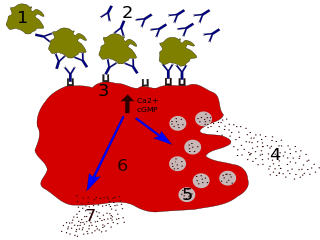
Immunoglobulin E (IgE) is a type of antibody that has been found only in mammals. IgE is synthesised by plasma cells. Monomers of IgE consist of two heavy chains and two light chains, with the ε chain containing four Ig-like constant domains (Cε1–Cε4). IgE is thought to be an important part of the immune response against infection by certain parasitic worms, including Schistosoma mansoni, Trichinella spiralis, and Fasciola hepatica. IgE is also utilized during immune defense against certain protozoan parasites such as Plasmodium falciparum. IgE may have evolved as a defense to protect against venoms.
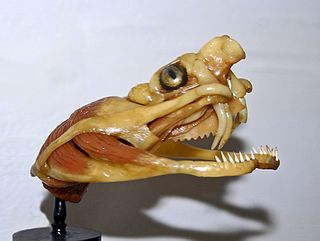
Snake venom is a highly toxic saliva containing zootoxins that facilitates in the immobilization and digestion of prey. This also provides defense against threats. Snake venom is usually injected by unique fangs during a bite, though some species are also able to spit venom.
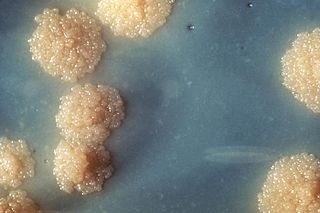
Evolutionary medicine or Darwinian medicine is the application of modern evolutionary theory to understanding health and disease. Modern biomedical research and practice have focused on the molecular and physiological mechanisms underlying health and disease, while evolutionary medicine focuses on the question of why evolution has shaped these mechanisms in ways that may leave us susceptible to disease. The evolutionary approach has driven important advances in the understanding of cancer, autoimmune disease, and anatomy. Medical schools have been slower to integrate evolutionary approaches because of limitations on what can be added to existing medical curricula. The International Society for Evolution, Medicine and Public Health coordinates efforts to develop the field. It owns the Oxford University Press journal Evolution, Medicine and Public Health and The Evolution and Medicine Review.
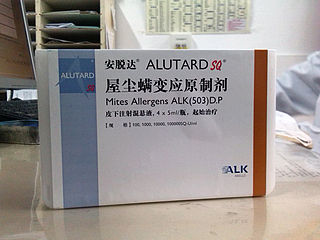
Allergen immunotherapy, also known as desensitization or hypo-sensitization, is a medical treatment for environmental allergies and asthma. Immunotherapy involves exposing people to larger and larger amounts of allergens in an attempt to change the immune system's response.

The Schmidt sting pain index is a pain scale rating the relative pain caused by different hymenopteran stings. It is mainly the work of Justin O. Schmidt, who was an entomologist at the Carl Hayden Bee Research Center in Arizona. Schmidt published a number of works on the subject and claimed to have been stung by the majority of stinging Hymenoptera.
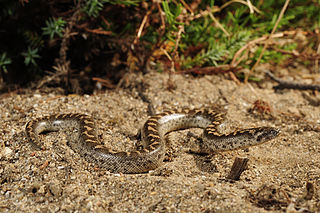
A psychological adaptation is a functional, cognitive or behavioral trait that benefits an organism in its environment. Psychological adaptations fall under the scope of evolved psychological mechanisms (EPMs), however, EPMs refer to a less restricted set. Psychological adaptations include only the functional traits that increase the fitness of an organism, while EPMs refer to any psychological mechanism that developed through the processes of evolution. These additional EPMs are the by-product traits of a species’ evolutionary development, as well as the vestigial traits that no longer benefit the species’ fitness. It can be difficult to tell whether a trait is vestigial or not, so some literature is more lenient and refers to vestigial traits as adaptations, even though they may no longer have adaptive functionality. For example, xenophobic attitudes and behaviors, some have claimed, appear to have certain EPM influences relating to disease aversion, however, in many environments these behaviors will have a detrimental effect on a person's fitness. The principles of psychological adaptation rely on Darwin's theory of evolution and are important to the fields of evolutionary psychology, biology, and cognitive science.

Helminthic therapy, an experimental type of immunotherapy, is the treatment of autoimmune diseases and immune disorders by means of deliberate infestation with a helminth or with the eggs of a helminth. Helminths are parasitic worms such as hookworms, whipworms, and threadworms that have evolved to live within a host organism on which they rely for nutrients. The theory behind helminth therapy is that these worms reduce negative immune responses due to their TH2 immune response that downregulates the abnormal T-cell responses recently associated with autoimmune disorders. This therapy ties to the Hygiene hypothesis in that the lack of exposure to bacteria and parasites such as helminths can cause a weaker immune system leading to being more susceptible to autoimmune disease.

Toxicofera is a proposed clade of scaled reptiles (squamates) that includes the Serpentes (snakes), Anguimorpha and Iguania. Toxicofera contains about 4,600 species of extant Squamata. It encompasses all venomous reptile species, as well as numerous related non-venomous species. There is little morphological evidence to support this grouping; however, it has been recovered by all molecular analyses as of 2012.
Immune dysregulation is any proposed or confirmed breakdown or maladaptive change in molecular control of immune system processes. For example, dysregulation is a component in the pathogenesis of autoimmune diseases and some cancers. Immune system dysfunction, as seen in IPEX syndrome leads to immune dysfunction, polyendocrinopathy, enteropathy, X-linked (IPEX). IPEX typically presents during the first few months of life with diabetes mellitus, intractable diarrhea, failure to thrive, eczema, and hemolytic anemia. unrestrained or unregulated immune response.

Sickness behavior is a coordinated set of adaptive behavioral changes that develop in ill individuals during the course of an infection. They usually, but not always, accompany fever and aid survival. Such illness responses include lethargy, depression, anxiety, malaise, loss of appetite, sleepiness, hyperalgesia, reduction in grooming and failure to concentrate. Sickness behavior is a motivational state that reorganizes the organism's priorities to cope with infectious pathogens. It has been suggested as relevant to understanding depression, and some aspects of the suffering that occurs in cancer.

Jellyfish dermatitis is a cutaneous condition caused by stings from a jellyfish.
Menstruation is the shedding of the uterine lining (endometrium). It occurs on a regular basis in uninseminated sexually reproductive-age females of certain mammal species.

Venom in snakes and some lizards is a form of saliva that has been modified into venom over its evolutionary history. In snakes, venom has evolved to kill or subdue prey, as well as to perform other diet-related functions. While snakes occasionally use their venom in self defense, this is not believed to have had a strong effect on venom evolution. The evolution of venom is thought to be responsible for the enormous expansion of snakes across the globe.

Three-finger proteins or three-finger protein domains are a protein superfamily consisting of small, roughly 60-80 amino acid residue protein domains with a common tertiary structure: three beta strand loops extended from a hydrophobic core stabilized by disulfide bonds. The family is named for the outstretched "fingers" of the three loops. Members of the family have no enzymatic activity, but are capable of forming protein-protein interactions with high specificity and affinity. The founding members of the family, also the best characterized by structure, are the three-finger toxins found in snake venom, which have a variety of pharmacological effects, most typically by disruption of cholinergic signaling. The family is also represented in non-toxic proteins, which have a wide taxonomic distribution; 3FP domains occur in the extracellular domains of some cell-surface receptors as well as in GPI-anchored and secreted globular proteins, usually involved in signaling.

Paul W. Sherman is a professor Emeritus at Cornell University in animal behaviour best known for his work on the social behavior of rodents, eusociality, and evolutionary medicine.
References
- ↑ Profet, Margie (September 1993). "Menstruation as a Defense Against Pathogens Transported by Sperm". The Quarterly Review of Biology. 68 (3). Chicago, Illinois: The University of Chicago Press: 335–386. doi:10.1086/418170. ISSN 0033-5770. JSTOR 2831191. PMID 8210311. S2CID 23738569.
- ↑ Profet, Margie (March 1991). "The Function of Allergy: Immunological Defense Against Toxins". The Quarterly Review of Biology. 66 (1). Chicago, Illinois: The University of Chicago Press: 23–62. doi:10.1086/417049. ISSN 0033-5770. JSTOR 2830331. PMID 2052671. S2CID 5648170.
- ↑ Profet, Margie (1988). "The Evolution of Pregnancy Sickness as Protection to the Embryo Against Pleistocene Teratogens". Evolutionary Theory. 8: 177–190.
- ↑ Profet, Margie (1992). "Chapter 8: Pregnancy Sickness as Adaptation: A Deterrent to Maternal Ingestion of Teratogens". In Barkow, Jerome H.; Cosmides, Leda; Tooby, John (eds.). The Adapted Mind: Evolutionary Psychology and the Generation of Culture. Oxford University Press. pp. 327–366. ISBN 978-0-19-506023-2.
- ↑ Mcdermott, Terry (31 July 1994). "Darwinian Medicine—It's a War Out There and Margie Profet, a Leading Theorist in a New Science, Thinks the Human Body Does Some Pretty Weird Things to Survive". Seattle Times Newspaper.
- ↑ "Fellows List – P". MacArthur Foundation. Archived from the original on 12 April 2011. Retrieved 2 April 2011.
- ↑ Angier, Natalie (21 September 1993). "Radical New View of Role of Menstruation". The New York Times.
- ↑ Holloway, Marguerite (April 1996). "Evolutionary Theories for Everyday Life". Scientific American. Archived from the original on 21 February 1999.
- ↑ Bloch, Hannah (4 October 1993). "School Isn't My Kind of Thing". Time.
- ↑ Plummer, William (11 October 1993). "A curse no more". People Magazine. Vol. 40, no. 15.
- ↑ Rudavsky, Shari (May 1994). "Margie Profet: Co-evolution". Omni (Interview). Archived from the original on 15 March 2008.
- ↑ Flaxman, Samuel M.; Sherman, Paul (June 2000). "Morning sickness: a mechanism for protecting mother and embryo". Quarterly Review of Biology. 75 (2). University of Chicago Press: 113-148. doi:10.1086/393377. PMID 10858967.
- ↑ Sherman, Paul W.; Holland, Erica; Sherman, Janet Shellman (2008). "Allergies: Their Role in Cancer Prevention". The Quarterly Review of Biology. 83 (4). University of Chicago Press: 339–362. doi:10.1086/592850. ISSN 0033-5770. PMID 19143335. S2CID 42767681.
- ↑ Martin, M. (20 February 2012). "Research Reinforces Potential Allergies-Glioma Connection". JNCI Journal of the National Cancer Institute. 104 (5). Oxford University Press: 353–356. doi: 10.1093/jnci/djs153 . ISSN 0027-8874. PMID 22349202.
- ↑ Tsai, Mindy; Starkl, Philipp; Marichal, Thomas; Galli, Stephen J (October 2015). "Testing the 'toxin hypothesis of allergy': mast cells, IgE, and innate and acquired immune responses to venoms". Current Opinion in Immunology. 36: 80–87. doi:10.1016/j.coi.2015.07.001. PMC 4593748 . PMID 26210895.
- ↑ Palm, Noah W.; Rosenstein, Rachel K.; Yu, Shuang; Schenten, Dominik D.; Florsheim, Esther; Medzhitov, Ruslan (2013). "Bee Venom Phospholipase A2 Induces a Primary Type 2 Response that Is Dependent on the Receptor ST2 and Confers Protective Immunity". Immunity. 39 (5): 976–985. doi:10.1016/j.immuni.2013.10.006. PMC 3852615 . PMID 24210353.
- ↑ Marichal, Thomas; Starkl, Philipp; Reber, Laurent L.; Kalesnikoff, Janet; Oettgen, Hans C.; Tsai, Mindy; Metz, Martin; Galli, Stephen J. (2013). "A Beneficial Role for Immunoglobulin E in Host Defense against Honeybee Venom". Immunity. 39 (5): 963–975. doi:10.1016/j.immuni.2013.10.005. PMC 4164235 . PMID 24210352.
- ↑ Sharlach, Molly (24 October 2013). "Bee sting allergy could be a defense response gone haywire, scientists say". Stanford Medicine News Center. Retrieved 20 November 2019.
- ↑ Foley, James A. (25 October 2013). "Severe Allergies to Bee Stings may be Malfunctioning Evolutionary Response". Nature World News.
- ↑ Gold, Sylviane (12 October 2012). "Women on the Verge of an Explanation: A Review of 'The How and the Why,' at Penguin Rep Theater". The New York Times .
- ↑ Martin, Mike (1 May 2012). "The Mysterious Case of the Vanishing Genius". Psychology Today. Archived from the original on 2013-02-01.
- ↑ Martin, Mike (29 May 2012) [2009]. "Margie Profet's Unfinished Symphony". Weekly Scientist. Archived from the original on 24 October 2013. Retrieved 20 November 2019.
- ↑ Maher, Brendan (31 May 2012). "Missing biologist surfaces, reunites with family". blogs.nature.com.